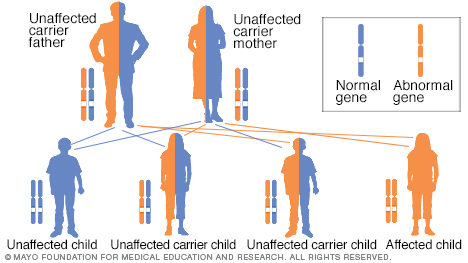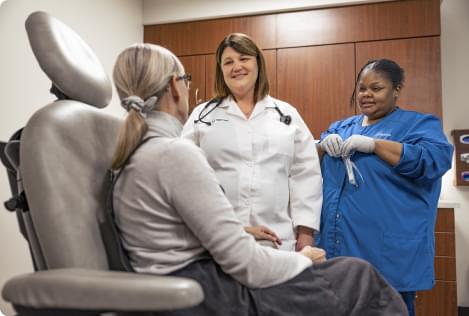Overview
Gaucher (go-SHAY) disease is a rare, inherited condition that leads to the buildup of a fatty substance in tissues. This buildup causes damage and dysfunction of tissues and organs. The spleen, liver and bones are most often affected.
There are three general types of Gaucher disease. More than 90% of cases are type 1.
Primary treatments either break down the fatty substance or limit its production. Regular tests are done to monitor treatments and look for signs of tissue damage.
Type 1 Gaucher disease is more common among people with Eastern and Central European Jewish ancestry, also called Ashkenazi Jews.
Symptoms
Some symptoms are shared by all types of Gaucher disease, but each type varies in important ways.
Type 1
Symptoms vary in severity. In some cases, a healthcare professional may find signs of the disease before symptoms appear. Symptoms most often appear in childhood or teenage years, but they can begin at any age. Signs and symptoms of type 1 Gaucher disease include:
- Enlarged organs. The spleen becomes greatly enlarged. The liver also may become enlarged. The effects may include:
- Easy bruising or bleeding because of blood platelets trapped in the spleen.
- Tissue damage or scarring in the spleen or liver.
- Belly pain or discomfort.
- Bone conditions. Weakened and irregular bones may cause:
- Bone pain.
- Bone fractures, even with no apparent injury.
- Bone marrow disorders. Bone marrow may not produce enough healthy blood cells causing:
- Low blood platelet production that leads to easy bruising or bleeding.
- Low red blood cell production that causes fatigue.
- Lung disease. Less often, the disease may affect breathing because of:
- Damage to lung tissues.
- Restrictions on the lungs caused by an enlarged spleen or liver.
- High blood pressure in the lungs.
- Growth disorders. Some children with type 1 Gaucher disease experience:
- Delayed or limited growth.
- Delayed puberty.
Type 2
Type 2 Gaucher disease is the least common. The disease causes the rapid loss of cells in the brain stem. This part of the brain controls breathing, muscle control and other important functions.
Symptoms appear within the first few months of life. Death usually occurs within two years.
Type 3
Type 3 Gaucher disease causes symptoms of type 1. It also causes some nervous system disorders and the progressive loss of brain cells. Symptoms begin during childhood. They include:
- Eye movement disorders.
- Muscle spasms.
- Seizures.
- Loss of muscle control in adolescents or early adulthood.
- Dementia in adolescents or early adulthood.
When to see a doctor
If you or your child has symptoms associated with Gaucher disease, make an appointment with your healthcare professional.
Causes
A fatty substance, called glucocerebroside, is a part of a cell's wall and plays an important role in cell activity. When a cell dies, a particular enzyme breaks down this fatty substance.
In Gaucher disease, the gene responsible for making this enzyme has an irregular change, called a mutation. The fatty substances aren't broken down. Instead, they build up in white blood cells that are responsible for eating up the debris from dead cells.
These irregular white blood cells, called Gaucher cells, damage tissues.
Inheritance pattern
Gaucher disease is passed along to a child when both parents carry a Gaucher-related gene mutation. A child gets one mutated gene from each parent. This inheritance pattern is called autosomal recessive.
Children who inherit only one mutated gene do not get the disease. But they can, in turn, pass along the mutation.

Risk factors
People of Eastern and Central European Jewish ancestry, called Ashkenazi Jews, are at a higher risk than the general population of developing type 1 Gaucher disease.
Complications
Complications of type 1 Gaucher disease include:
- Parkinson's disease risk. People with type 1 Gaucher disease have a greater risk of developing Parkinson's disease than the general population. People who carry one copy of a Gaucher-related gene mutation also have an increased risk. Also, there's an increased risk of the related disorder called Lewy body dementia.
- Cancer risk. People with type 1 Gaucher disease have an increased risk of cancers of bone marrow and blood.
- Pregnancy complications. Gaucher disease symptoms may worsen during pregnancy. Also, there's an increased risk of bleeding after delivery.
Diagnosis
A complete exam typically includes questions about symptoms and family medical history. Diagnostic exams may include:
- Applying pressure to the belly to check the size and condition of organs.
- Measurements of height and weight of children and a review of growth charts.
- Tests of movement, coordination and reflexes.
- Examination of skin for signs of bruising.
Lab tests
Blood samples can be used to examine the enzyme associated with Gaucher disease. Genetic analysis can show the presence of a gene change related to the disease. These are the primary tests for confirming a diagnosis.
Imaging tests
Imaging tests look for signs of damage to tissues and organs caused by Gaucher disease. These include:
- MRI scans or ultrasounds to see the size of the spleen and liver.
- MRIs to detect the presence of Gaucher cells in tissues.
- X-rays to assess bone disease.
- Specialized X-ray technology, called dual x-ray absorptiometry, to measure bone density.
Genetic screening
Prenatal screening can test for disease-related enzyme levels and gene mutations. This information has little value in predicting the severity of the disease. Even siblings with the disease can have very different disease outcomes.
Genetic screening tests also are available to parents who may be likely carriers of a Gaucher-related gene mutation. Genetic counseling is recommended to understand the benefits, limitations and risks of genetic testing.
Treatment
Treatment goals for type 1 Gaucher disease are to lessen symptoms, prevent damage to tissues and organs, and improve quality of life. Regularly scheduled imaging tests monitor disease progression and treatment effect.
Enzyme replacement therapy
This treatment provides an artificial enzyme to replace the enzyme that doesn't work correctly in Gaucher disease. The medicine is given through an intravenous (IV) tube with a needle inserted into a blood vessel. The treatment is done every two weeks.
A possible side effect is a rare but serious allergic reaction. The healthcare team monitors for any problems during the treatment.
Medicine to reduce fatty substances
Other medicines limit the production of the Gaucher-related fatty substance. These medicines are taken daily as pills. They include:
- Miglustat (Opfolda, Yargesa, Zavesca)
- Eliglustat (Cerdelga)
Side effects include:
- Diarrhea.
- Belly pain.
- Weight loss.
- Gas.
- Tremors.
- Tingling, numbness or pain in limbs.
Other medicines
Other medicines are used to treat bone pain and limit the amount of bone loss.
Surgery
Removal of the spleen, called a splenectomy, may be used in some situations:
- Very low blood platelets because of platelets being trapped in the spleen.
- Severe belly pain or other issues related to an enlarged spleen.
Bone marrow transplants may treat the disorder but are rarely used because of risks of severe side effects and death.
Treatment of types 2 and 3
There is no disease-altering treatment for type 2 Gaucher disease. Treatment is focused on supportive care and pain management.
Type 3 Gaucher disease may be treated with enzyme replacement therapy. This treatment doesn't affect disease progression in the brain.
Bone marrow transplants may be used for people with type 3 Gaucher disease before there are any signs or symptoms of brain disease.
Coping and support
Individuals and families affected by Gaucher disease face challenges in managing care and coping with the stress of a lifelong illness. The National Gaucher Foundation and the Gaucher Community Alliance have resources for community services, support groups and education.
Preparing for an appointment
You'll likely start by seeing your primary healthcare professional. You will likely see other specialists such as doctors who specialize in blood disorders, called hematologists, or specialists in inherited disorders, called geneticists.
What you can do
Before your appointment, make a list that includes:
- Symptoms, including any that seem unrelated to the reason for the appointment.
- Key personal information, including major stresses, recent life changes and family medical history.
- All medicines, vitamins or other supplements you take, including the doses and reasons for taking them.
- Questions to ask your healthcare professional.
Take a family member or friend along, if possible, to help you remember the information you're given. Some basic questions to ask your healthcare professional include:
- What tests will you order?
- What specialists should I see?
- What illnesses need to be considered or ruled out based on the symptoms?
- What can be done to manage symptoms before you have made a diagnosis?
- Are there brochures or other printed material I can have? What websites do you recommend?
What to expect from your doctor
Be prepared to answer the following questions about your symptoms or your child's symptoms:
- When did the symptoms begin?
- Have the symptoms been constant or do they happen off and on?
- How severe are the symptoms?
- Is there pain in bones or the belly?
- Have you noticed easy bruising or nosebleeds?
- What's your family's ancestral heritage?
- Is there a history of inherited illnesses in your family?
© 1998-2025 Mayo Foundation for Medical Education and Research (MFMER). All rights reserved. Terms of Use


